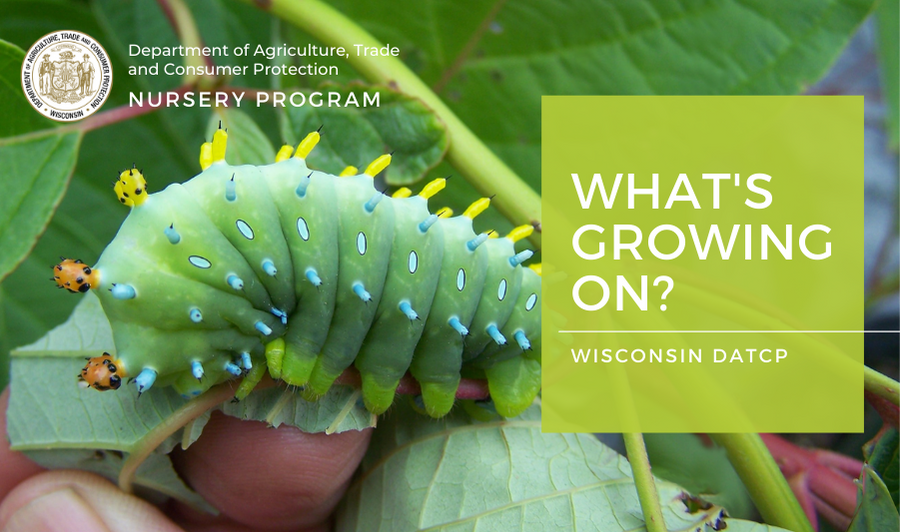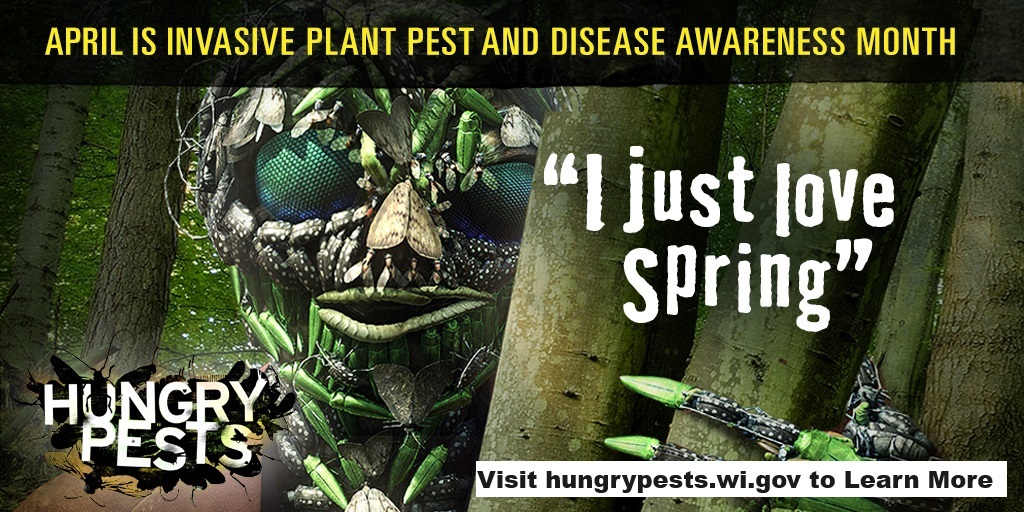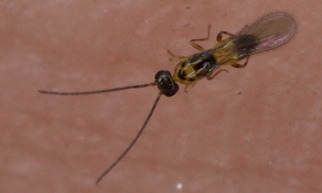|
 _____________________________________
Dear Wisconsin nurseries, Christmas tree growers, and gardeners:
After a slowdown in degree day accumulations the past few weeks, they are again starting to build. Growing degree days (GDD)(simple B50) as of April 14 were still 0 in Bayfield, 10 in Medford, 10 in Wausau, 27 in Hancock, 31 in Green Bay, 59 in Madison, 69 in Racine, and 56 in La Crosse. A few pests in a vulnerable-to-treatment stage include first applications for Cooley and eastern spruce gall adelgid, pine bark adelgid, and spruce needle miner (50-100 GDDs). Once we hit 100 GDD(B50), some pests in vulnerable stages include fletcher scale, spongy moth, boxwood psyllid, spruce spider mites, viburnum leaf beetle and Zimmerman pine moth (100-200 GDDs), to name a few.
Please send any feedback, questions, or ideas for future e-news updates to datcpnursery@wisconsin.gov.
Having trouble viewing this email? View it as a Web page.
_____________________________________
|
|

You can help prevent the spread of damaging invasive species by familiarizing yourself with invasive pests that threaten Wisconsin natural resources, following the "Don’t Move Firewood" rules, and following best management practices to avoid spreading invasives while working and enjoying recreational activities.
Many invasive plant pests and diseases are natural hitchhikers. It’s easy to unintentionally move them to new areas because they hitchhike in untreated firewood. They also attach themselves to cars, boats, and other outdoor surfaces that are moved around. Another means of spread is on agricultural material such as soil, seeds, homegrown produce, and plants. Review these best management practices to help prevent and minimize the spread of invasives.
Wisconsin’s “Dirty Dozen” are the top 12 invasive plants and diseases to know. Keep a lookout for wood-boring beetles like the Asian longhorned beetle and emerald ash borer on untreated firewood or other untreated wood products, like "rustic" wood furniture. Free identification training is available to everyone for spongy moth and spotted lanternfly. Help protect our state and economy by being able to recognize invasive pests and report them to the Pest Hotline at (866) 440-7523 or datcppesthotline@wi.gov.
To protect forest resources from harmful pests, find out the rules at your destination before bringing firewood and visit Wisconsin’s Firewood Rules and Resources page for statewide details. When in doubt, buy it where you burn it. To find local firewood vendors in Wisconsin, visit Firewood Scout or Certified Firewood Dealers in Wisconsin.
_____________________________________
|
|
|
Symptoms of tobacco mosaic virus on sedum | DATCP image
This is part 2 of a brief series on virus transmission methods to consider when working with plants.
There are many ways that viruses can spread between plants. Last month, we discussed insect vectors. Another way viruses can be spread is through mechanical transmission.
Symptoms of viral disease vary widely depending on the particular virus and host. Typical leaf symptoms include mosaic patterns, color bleeding along veins, chlorotic or necrotic lesions, ringspots, leaf rolling, curling, stunting, or other deformation.
Many plant viruses can spread via mechanical transmission, meaning through touch. Virus particles exist in the sap of infected plants. Anything that wounds the plant or touches this sap, and then touches a healthy plant, can spread the virus. This includes machinery, equipment, tools, and hands.
Tobacco mosaic virus is an example of a very stable virus that is easily spread by mechanical transmission. It can survive in dried plant sap on tools, plant surfaces, etc. for years.
Make sure to disinfect tools, hands, and equipment after handling plants. Wear disposable gloves, booties, or suits to make cleanup easier. Properly dispose of plants symptomatic for virus to prevent spread to other plants. Plants infected with virus cannot be sold since there are no curative treatment options for virus-infected plants.
_____________________________________
|
|
|
Exit holes of C. flavipes in a twig | Whitney Cranshaw, Colorado State University, Bugwood.org
Since February 2024, there have been reports of unusual bark damage on swamp White (Quercus bicolor) and bur oaks (Q. macrocarpa) between 2-8” in diameter in Chicago and several other suburban communities in Northeastern Illinois. Symptoms have included strips of outer bark that have been pulled up in strips or pulled off the tree. While bark peeling does not extend into the cork cambium layer, that layer is pitted, and looks as if the cambium had been scooped out by a tiny melon baller. Inside the holes are not discolored, and no fungi appear to be associated with them. The issue was so alarming that the Illinois Landscape Contractors Association (ILCA) put out a notice asking people to watch for and report these mysterious symptoms.
As it turns out, the southeastern DATCP nursery inspector recalled similar damage on a bur oak trunk sample with pitting, woodpecker damage, and emerging wasp-like insects that she submitted to our laboratory from a nursery in Walworth County in November 2020. Thousands of gall wasps emerged between when the sample arrived and when it was processed. The DATCP entomologist attributed damage to an abundance of cynipid gall wasps, likely Callirhytis flavipes, or the wool sower wasp, found just beneath the bark surface. This native gall wasp lives beneath the bark in winter before emerging and producing leaf galls in summer. Fortunately, when DATCP received the notice from ILCA, we were able to share our past identification with WNLA President Jonathan Stickels. He, in turn, alerted the Morton Arboretum, ILCA, and other colleagues. It has been great to see how modern communications lent insights into this mysterious pest!
Unfortunately, an article on Callirhytis wasps from NC State Extension mentions that once a twig damage is observed, it is hard to control these pests. This article suggests that heavily infested and declining trees might have been predisposed to stress due to poor growing conditions. Nitrogen fertilization can also make the problem worse. Could another factor be our ongoing drought? More information about C. flavipes was reported in an article from South Dakota Extension in 2019. It highlights the fact that while the wasps may not cause significant damage, woodpecker feeding on young trees can lead to bark removal and tree mortality.
_____________________________________
|
|

This is the fifth in a series of articles to focus on the natural predators of many of the common pest species found in nurseries and Christmas tree fields.
Image right: Fairy Wasp by gbohne, Flickr
|
Insects can be quite small, but if there was a gold medal for tiny, it would go the family of wasps in Mymaridae, otherwise known as the fairyflies. These wasps make most insects look giant in comparison. The average about .5 mm (.02 inches) long, which is about half the length of the tip of pencil. One of the more remarkable traits of these wasps are their wings. Wings are often reduced and covered with fine long bristles called setae. By moving these setae at different points in a wing stroke, fairyflies can reduce drag and increase energy efficiency. This is important because when your body is at this tiny of scale, every bit of energy is valuable. Their small size often comes with other compromises as well. Fairyfly adults don’t tend to live long, with a lifespan of only a few days, which is just long enough for them to locate a new egg host for the next generation.
One might be curious how such small insects could be effective predators, yet they are both very successful as natural predators and as biological pest control. Fairyflies as a family are uniformly egg parasites. They lay their eggs on or in other insects’ eggs, developing completely inside. Being so small, often multiple wasp larva can develop within the same egg. Some species can complete their whole life cycle within their host egg, with only the adult female emerging to find a new host. They also tend to parasitize a wide range of hosts, which is why they are being studied for use as a biological control in agricultural crops.
_____________________________________
|
|
|
Repackaging seed for sale requires a Seed Labeler License | DATCP, K. Jerabek
A reminder to anyone selling seed for planting out of bulk bins or anyone selling seed for planting that they've repackaged: you likely need a Seed Labeler License from DATCP.
A seed labeler is any business or person whose name appears on a seed label or who opens containers of agricultural, lawn, or vegetable seed to sell all or part of. Labels must include information about the percentages of different kinds of seeds in the package and information on germination, as well as treatment, inoculation, or coating. Complete labeling requirements are listed in Wis. Admin. Code § ATCP 20.
Another issue commonly encountered during seed inspections, besides not having a license if needed, is when expired seed is found being offered for sale. Retailers should regularly inspect seed being sold and if the seed is expired, it cannot be sold until it has been retested and relabeled. Selling expired seed is a violation of the seed law under Administrative Code, ATCP 20.04 and 20.06.
You do not need a seed label license if you sell:
- Seed grown and sold exclusively on your own farm
- Seed in unopened bags or containers labeled by a licensed seed labeler
Seed licenses are annual, effective January 1 through December 31. The cost is based on gross annual sales and ranges from $25 for sales less than $10,000 up to $2,500 for sales of $100 million or more. A complete fee schedule is available in Wis. Stat. § 94.43-46.
_____________________________________
|
|
|
|
|